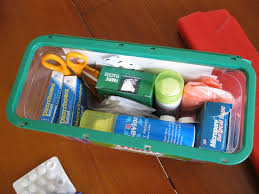Still sorting out our new house and today it the first aid kit. I looked up 'what to put in a home first aid kit' and found this answer under NHS Choices (http://www.nhs.uk/chq/pages/990.aspx?CategoryID=72&SubCategoryID=725):

A basic first aid kit may contain:
plasters, in a variety of different sizes and shapes
small, medium and large sterile gauze dressings
at least two sterile eye dressings
triangular bandages
crêpe rolled bandages
safety pins
disposable sterile gloves
tweezers
scissors
alcohol-free cleansing wipes
sticky tape
thermometer, preferably digital
skin rash cream, such as hydrocortisone or calendula
cream or spray to relieve insect bites and stings
antiseptic cream
painkillers such as paracetamol (or infant paracetamol for children), aspirin (not to be given to children under 16), or ibuprofen
cough medicine
antihistamine tablets
distilled water, for cleaning wounds and as an eye bath
 We've always kept our first aid and medicines in our bedroom but, on reflection, what would happen if a visitor or house guest wanted access to first aid? So now I've put it in the enormous bathroom cabinet (which would otherwise be empty as all our stuff is in the en suite to our bedroom).
We've always kept our first aid and medicines in our bedroom but, on reflection, what would happen if a visitor or house guest wanted access to first aid? So now I've put it in the enormous bathroom cabinet (which would otherwise be empty as all our stuff is in the en suite to our bedroom).
Having said that, many people say that more accidents happen in the kitchen than the bathroom, so that's the best place to keep the first aid kit ...
Here's another site (http://www.wikihow.com/Create-a-Home-First-Aid-Kit). It recommends having a container with two compartments: one for general first aid stuff and one for medicines for the family itself.
 On other sites suggestions have also included:
On other sites suggestions have also included:
- torch
- cool pad (or could use a bag of frozen peas)
- burn cream (10 mins in cold water works wonders too)
For children see: http://kidshealth.org/parent/firstaid_safe/home/firstaid_kit.html
and for babies: http://www.babycentre.co.uk/a762/first-aid-kit-shopping-list
Finally, here's a useful video: https://www.youtube.com/watch?v=Mhab4Gp-hq4
No comments:
Post a Comment